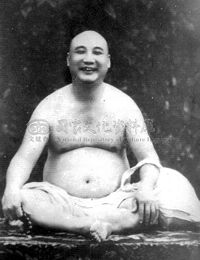Views
There are at least two Chinese monks who went by this name in the 20th century.
Contents |
Cíháng (1) 慈航 (1869-1919)
Cíháng 慈航 (1869-1919)
|
| Notable Associates:
|
|
Short bio.
Biography
Cíháng ordained at the age of 17 suì 歲 (1885) at Qīngcháo Temple 清潮寺. He was known as Cíháng "Compassionate Boat" because he worked hard for the people around his temple, this work including running a ferry for them to get across the lake upon which the town was located.
Notes
References
- Yú Língbō 于凌波, ed. Xiàndài Fójiào rénwù cídiǎn 現代佛教人物辭典 (A Dictionary of Modern Buddhist Persons), 2 vols. Taipei: Foguang, 2004. Pp. 2.1284b-1285a.
Cíháng (1) 慈航 (1895-1954)
Cíháng 慈航 (1895-1954)
|
| Notable Associates:
|
|
Short bio.
Biography
Cíháng's mother died when he was 10 suì 歲, and his father died two years later. Cíháng was then raised by an aunt and uncle. As a young man he learned his uncle's trade, which was the making of monastic robes. During this time he visited many temples, and eventually decided to become a monk. He tonsured under Zìzhōng 自忠 in 1912, and then went to Néngrén Temple 能仁寺 in Jiāngxī 江西 to receive full ordination the following year.
From 1912 to 1927, Cíháng visited many famous centers of monastic learning and studied under Dìxián 諦閑, Yúanyīng 圓瑛, and Èlǎo 厄老.
In September of 1927 he became a student at the Mínnán Buddhist Seminary 閩南佛學院. At that time, Tàixū 太虛 (the abbot of the overseeing monastery) was often away. Later that winter, a conflict broke out between those running the monastery and one Xuécháo 學潮. Although Cíháng was not part of this fight, he was implicated in Xuécháo's group, and left the seminary voluntarily.
In the fall of 1928, Cíháng was asked by Zhú'ān 竺庵 to become abbot of Yíngjiāng Temple 迎江寺 in Ānqìng 安慶.
As reported in Welch[1], Cíháng's body was famously exhumed on May 19, 1959 and when he body was found to be more or less intact, he was mummified according the practices of the Chinese Buddhist tradition.[2]
Important Works
Notable Students
Notes
- ↑ Welch, Holmes. The Practice of Chinese Buddhism: 1900-1950. Cambridge: Harvard University Press, 1967. Pp. 343-344.
- ↑ A slideshow of the mummification process can be viewed here.
References
- Shì Dōngchū 釋東初. Zhōngguó Fójiào jìndài shǐ 中國佛教近代史 (A History of Early Contemporary Chinese Buddhism), in Dōngchū lǎorén quánjí 東初老人全集 (Complete Collection of Old Man Dongchu), vols. 1-2. Taipei: Dongchu, 1974 Pp. 2.927-931.
- Yú Língbō 于凌波, ed. Xiàndài Fójiào rénwù cídiǎn 現代佛教人物辭典 (A Dictionary of Modern Buddhist Persons), 2 vols. Taipei: Foguang, 2004. Pp. 2.1285b-1288b.
